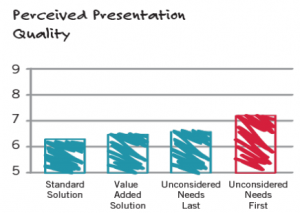Putting an “Unconsidered Needs” Message to the Test
The idea of linking a prospects’ unconsidered needs to your unexpected strengths sounds like it has potential as a message differentiator. But an interesting theory doesn’t always flower into an actionable practice, and we felt the concept deserved a closer look…so that’s what we gave it.
Corporate Visions teamed up with Dr. Zakary Tormala, a social psychologist with expertise in messaging and persuasion, to put the “unconsidered needs” approach to the test. Specifically, we wanted to test its messaging effectiveness against more traditional approaches, such as responding to the stated or known needs of your prospects, as well as the typical “value-added” approach many salespeople use to create differentiation.
For the study, we enlisted 400 individuals to take part in an online experiment. We asked participants to imagine they ran a large company and were considering partnering with a financial lending firm to explore growth opportunities in the face of an economic downturn, which was causing slow sales cycles and cash flow challenges. All participants were instructed to imagine they were seeking a $10 million line of credit and were told they would view a pitch from a particular lender who’d like to partner with them.
 What participants didn’t know is that they were randomly assigned to one of four different messaging pitches or conditions—a standard pitch, a value-added pitch, and two pitches that presented an unconsidered need (one at the beginning of the pitch, the other at the end).
What participants didn’t know is that they were randomly assigned to one of four different messaging pitches or conditions—a standard pitch, a value-added pitch, and two pitches that presented an unconsidered need (one at the beginning of the pitch, the other at the end).
So which pitch won in the areas of presentation quality, perceived uniqueness, and in critical attitude and choice measures? It turns out that a pitch that presents an “unconsidered need” first gives sellers a statistically significant advantage in the areas above, compared to traditional approaches…and the margin of difference wasn’t even close.
The study found that leading with an unconsidered need outperformed the other approaches by:
+11 percent in terms of presentation quality.
A whopping +41 percent in terms of presentation uniqueness.
+10 percent in attitude and choice measures, which assessed how much the message enhanced attitudes toward the lending partner and boosted purchase intent.
According to Tormala, the results are consistent with uncertainty research, which shows that highlighting unconsidered needs is unexpected and promotes uncertainty, which in turn accelerates decision processing.
Want to see an example of a pitch that connects unconsidered needs to unconsidered strengths, and learn more about the results of the study? Check out the research brief.
Timothy Riesterer's Blog
- Timothy Riesterer's profile
- 3 followers



